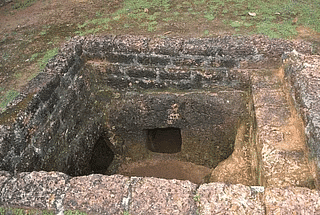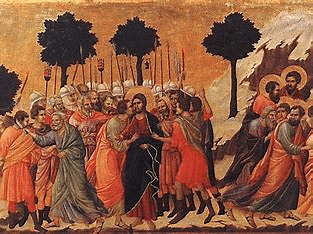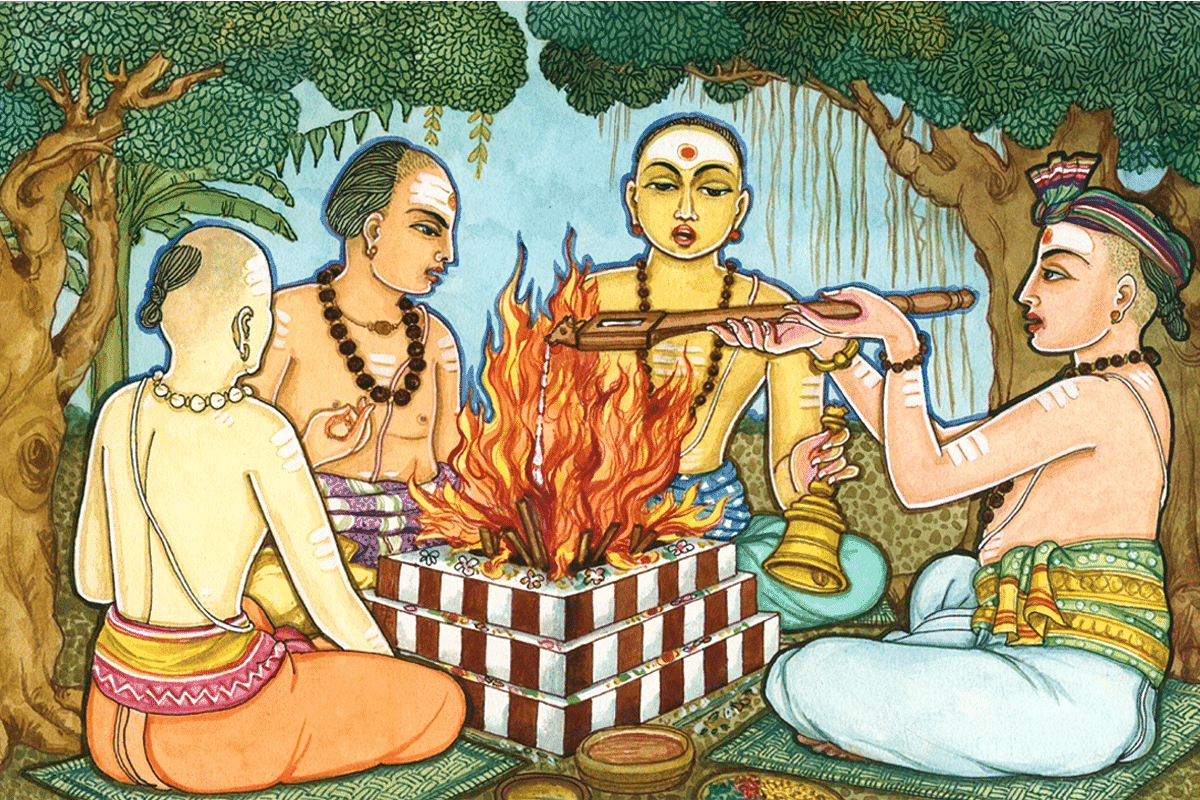UPSC Exam > UPSC Notes > History for UPSC CSE > Old NCERT Summary (RS Sharma): The Dawn of History in the Deep South
Old NCERT Summary (RS Sharma): The Dawn of History in the Deep South | History for UPSC CSE PDF Download
| Table of contents |

|
| The Megalithic Background |

|
| Three Early Kingdoms |

|
| The Purse and the Sword |

|
| Rise of Social Classes |

|
| Beginnings of Brahmanism |

|
| Tamil Language and Sangam Literature |

|
The Dawn of History in the Deep South
The Deep South began with Europeans coming in, using farming with enslaved people. The Civil War changed things, ending slavery. After that, they tried to make things fair, but discrimination continued for a long time. In the 1900s, the Deep South was where people fought for equal rights. Nowadays, it keeps its culture while also changing with the times.
 Slavery In South
Slavery In South
The Megalithic Background
Megaliths are big rocks people used long ago to make structures like monuments or tombs. They're ancient stones placed together without cement, often with mysterious purposes, found worldwide in places like Stonehenge or ancient burial sites.
- People in southern India, known as megalith builders, buried their dead in megaliths—graves circled by large stones.
- These graves contained pottery, iron tools, and weapons, suggesting a belief in an afterlife.
- These people used iron for tools but didn't engage in advanced farming.
- Megaliths were commonly found in areas like eastern Andhra and Tamil Nadu from around 1000 B.C. to the early Christian era.
- Paddy and Ragi is produced by people.

Megalithic Burial
Question for Old NCERT Summary (RS Sharma): The Dawn of History in the Deep South
Try yourself:
What are megaliths?View Solution
Three Early Kingdoms
 Chola|Chera|Pandya
Chola|Chera|Pandya
Pandya Kingdom
- Encompassed southern and south-eastern India: covered areas like Tirunelveli, Ramnad, and Madurai in Tamil Nadu.
- Capital: Madurai (also known as Mathura in Tamil).
- Sangam literature lacks detailed accounts but hints at affluence and profitable trade with the Roman Empire.
- Influential in Vedic sacrifices and had connections with Brahmanas.
Chola Kingdom
- Positioned northeast of Pandya, between the Pennar and Velur rivers.
- Hub: Uraiyur, known for cotton trade.
- Notable period: 2nd century A.D. under King Karikala, who established Puhar as the capital and developed extensive trade along the Kaveri river.
- Flourished in cotton cloth trade and had a strong navy, but faced decline due to conflicts with neighboring kingdoms and Pallava attacks
Chera Kingdom
- Located west and north of the Pandya region, covering parts of modern Kerala.
- Held significance equal to Cholas and Pandyas during the early Christian era due to Roman trade ties.
- Romans stationed forces at Muziris and established a temple of Augustus.
- Engaged in political clashes and alliances with Cholas and Pandyas. Trade of spices, ivory, pearls, silk, and muslin brought immense wealth, but decline in Roman trade led to decay.
 |
Download the notes
Old NCERT Summary (RS Sharma): The Dawn of History in the Deep South
|
Download as PDF |
Download as PDF
 Three Kingdoms
Three Kingdoms
The Purse and the Sword
 Purse, Bag & Sword
Purse, Bag & Sword
- Trade: Both foreign and internal trade served as a crucial revenue source for the kingdom. Custom officials managed trade activities in Puhar, collecting transit duties from moving merchants. Soldiers ensured road safety and curbed smuggling.
- Spoils of War: The kingdom's income was augmented by spoils obtained through warfare. However, the foundation of the kingdom's economy and warfare was primarily rooted in consistent agricultural revenue.
- Agricultural Income: While the specific portion of agricultural produce claimed by the king remains unspecified, it constituted the fundamental source of regular income for the kingdom.
- Agricultural Produce: The land yielded crops like paddy, ragi, sugarcane, and in the Kaveri delta, the space of an elephant's rest could feed seven individuals. The Tamil region also cultivated grains, fruits, pepper, and turmeric.
- King's Share: The king had a portion of the agricultural yield as part of his share in the produce.
- State's Military: Taxes from the peasantry maintained a standing army consisting of ox-drawn chariots, elephants, cavalry, and infantry. Elephants were crucial in warfare. Horses were imported by sea into the Pandyan kingdom.
- Army Composition: Nobles, princes, and army captains rode on elephants or drove chariots, while foot soldiers and horsemen wore leather sandals for foot protection.
Question for Old NCERT Summary (RS Sharma): The Dawn of History in the Deep South
Try yourself:
What was the primary source of regular income for the kingdom?View Solution
Rise of Social Classes
- King's Finances: Taxes funded the king's professional army and payments to poets and priests, mainly Brahmanas, who appeared in the Sangam age in Tamil land.
- Rewards for Poets: Poets, many of whom were Brahmanas, received generous rewards from kings, such as Karikala giving one poet 1,600,000 gold pieces, along with cash, land, chariots, horses, and even elephants.
- Brahmana Practices: Tamil Brahmanas consumed meat and wine, while the texts didn't regularly mention the Kshatriyas and Vaishyas. Warriors, titled enadi, played a vital role, and rich peasants, vallalas, held civil and military positions under Cholas and Pandyas.
- Social Structure: The ruling caste, arasar, had marital relations with vallalas, constituting the fourth caste, who held most of the land, forming the peasantry divided into rich and poor.
- Agricultural Workers: Women from the lowest class, known as kadistiyar, primarily conducted agricultural tasks, akin to the status of slaves, indicating minimal differences in their societal standing.
- Low-Class Artisans: The pulaiyans, categorized as low-class artisans, crafted rope charpaiys and utilized animal skins for mats. Several outcastes and forest tribes endured extreme poverty, leading hand-to-mouth existences.
- Social Disparities: The Sangam age exhibited marked social inequalities: the rich dwelled in brick and mortar houses, while the poor lived in humble huts. In cities, affluent merchants resided on upper storeys of their homes.
- Religious Influence on Social Hierarchy: It remains unclear whether rites and religion were employed to maintain social disparities. Although Brahmanas and the ruling caste were influential, distinct caste divisions prevalent in later times were absent during the early Sangam age.
Beginnings of Brahmanism
 Rise of Brahmanism
Rise of Brahmanism
- Brahmanical Influence: In the early Christian era, Tamil society was shaped by Brahmanism, but this influence was limited to a small portion of the Tamil territory and mostly to the upper echelons of society.
- Royal Practices: Kings conducted Vedic sacrifices, while Brahmanas engaged in debates, likely with Jainas and Buddhists. However, the primary local deity worshipped by the populace was Murugan, also known as Subramaniya.
- Religious Practices: Although the worship of Vishnu is mentioned, it might have emerged at a later period. The tradition of providing offerings, like paddy, to the dead from the megalithic era persisted. Cremation was introduced, but the ancient practice of inhumation from the megalithic phase persisted alongside.
Question for Old NCERT Summary (RS Sharma): The Dawn of History in the Deep South
Try yourself:
Which deity was primarily worshipped by the Tamil populace during the early Christian era?View Solution
Tamil Language and Sangam Literature
 Sangam Literature
Sangam Literature
- Sangam, a Gathering of Poets: Sangam was a collection of Tamil poets supported by the monarchy. It spanned three sessions lasting for 9990 years, involved 8958 poets, and enjoyed the patronage of 197 Pandya Kings.
- Sangam Literature's Timeframe: The available Sangam Literature was created approximately between A.D. 300-600. Over 76 brief inscriptions in a mix of Tamil and Prakrit, inscribed in Brahmi script, were discovered in natural caves around the Madurai region. These scripts date back to the first and second centuries when Jainism and Buddhism emerged in the area.
- Archaeological Evidence: Recent excavations have unearthed evidence of Tamil literature from the early Christian era. The compilation of Sangam literature was finalized around A.D. 600.
The document Old NCERT Summary (RS Sharma): The Dawn of History in the Deep South | History for UPSC CSE is a part of the UPSC Course History for UPSC CSE.
All you need of UPSC at this link: UPSC
|
113 videos|550 docs|173 tests
|
FAQs on Old NCERT Summary (RS Sharma): The Dawn of History in the Deep South - History for UPSC CSE
| 1. What are the three Early Kingdoms mentioned in the article? |  |
| 2. What is the significance of the rise of social classes in early South Indian history? |  |
Ans. The rise of social classes marked the development of a more complex society with distinct roles and hierarchies, shaping the political and economic landscape of the region.
| 3. How did the beginnings of Brahmanism impact early South Indian society? |  |
Ans. The beginnings of Brahmanism introduced new religious beliefs and practices, influencing social norms, rituals, and the organization of society in early South India.
| 4. What is the importance of Tamil language and Sangam literature in understanding the history of the region? |  |
Ans. Tamil language and Sangam literature provide valuable insights into the culture, society, and political dynamics of ancient South India, offering a glimpse into the lives of its people.
| 5. How did the megalithic background contribute to the socio-economic development of early South Indian societies? |  |
Ans. The megalithic background, characterized by burial practices and material culture, played a crucial role in shaping the social and economic structures of early South Indian societies, providing clues to their beliefs and way of life.
Related Searches























